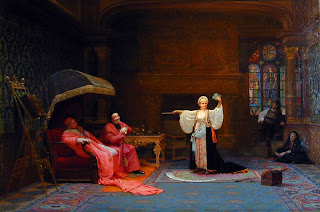Gad, I
love this picture.
We
continue our weeklong look at Jean
George Vibert (1840-1902) with one of his finest pictures, The Fortune Teller.
Vibert
served in the war of 1870-71 as a sharpshooter, and was wounded at the battle
of Malmaison in October of 1870. He was
awarded the Légion d’Honneur and
became a Chevalier de la Légion
d’Honneur for his efforts.
While recovering
from his war wounds, Vibert started writing plays, staging many productions and
sometimes serving as actor in his own works.
Not surprisingly, his plays mocked the establishment and contemporary
mores. He also wrote an operetta, Chanteuse par Amours, performed at the Variétés in 1877. It was at this time that he also starting
writing short stories Century Magazine
in the US, finding a free public relations bonanza in writing stories based on
his pictures.
Vibert
continued to submit work to the Salon until 1899 with L’Aigle et le Renard (The Eagle and the Fox). No slouch at self-promotion (or self-congratulation),
Vibert wrote of himself in the third person: …being an excellent cook, you have invented and
prepared sauces that make your compatriots lick their fingers; that, using your
pen as well as your brush, you have written songs and plays that have been
applauded in the minor theaters of Paris; that, following the example of
Molière, and having, like him, an extraordinary talent as an actor, you have
played your own productions at the club and in artistic salons; then, having a
passion for building, and trying your hand at all the trades, you are not only
your own architect, but do not disdain occasionally to work in iron, like Louis
XVI., or in wood, like the good St. Joseph; and finally that, in decorating
your house, you have distinguished yourself as an upholsterer. In the last
particular, you may even say that you surpass Molière, or he, although the son
of an upholsterer, was not himself one.
So, it
is no surprise that a man with such a dramatic turn of mind would paint a
picture as boldly dramatic as The Fortune Teller.
As with
other pictures we have seen, Vibert strives to render the clergy (particularly
cardinals) as both human and ridiculous.
Certainly good churchmen should have no traffic with such superstition
as fortune tellers or tricksters.
However, both cardinals (one amused, the other thoughtful) look on, an
enormous Gutenberg bible on the bookstand beside them.
As usual
with Vibert’s clergy, the cardinals are in a room of considerable
splendor. The gilt table, divan with canopy,
Oriental carpet and magnificent fireplace, though, all become a mere backdrop
to the drama of the fortune teller.
The Fortune
Teller herself stands as if in a spotlight.
Her confederates (other gypsies, perhaps?), stand ready upstage
left. Her raiment is as colorful and
dramatic as that of the cardinals, and the train of her dress follows the
flowing line of the train of one of the cardinal’s robes. Indeed, the Fortune Teller’s cards and box of
magic are proudly displayed, much like the on-display bible of the cardinals.
What is
perhaps most significant here – and why I think this is one of Vibert’s finest
works – is how the artist uses light. While
the Fortune Teller is in the ‘spotlight,’ so are the robes of the two
cardinals, linking the figures together.
More telling is the light from the stained glass windows near the other
gypsies – light comes from behind them, illuminating the figures modeled in
glass. But, aren’t the figures from
early Christian mythology more reminiscent of the costumes of the performing
gypsies than that of the cardinals? While
Vibert is drawing a parallel between the dawn of Christianity and the simple
superstitions of the gypsies, he is also commenting on the smug condescension of
the church. Notice the supercilious
smile of one of the cardinals. “Superstitious
peasants,” the look says. “We know so
much better.” However, Vibert points out
the amusing truth that there is little that separates the two.

No comments:
Post a Comment